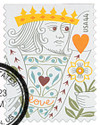
# 4404 - 2009 44c Love Series: King of Hearts
King of Hearts
Love Series
Issue Date: May 8, 2009
City: Washington, DC
Valentines, wedding invitations, and playing cards have been greatly influenced by Aelius Galenus (129-200 AD). The prominent physician and philosopher theorized passion resided in the liver, while the heart housed emotions.
Ancient Egyptians were among the first to associate romance with the heart. Early Egyptians believed the vein in the fourth finger of the left hand ran directly to the heart. Rings fashioned from plants grown on the banks of the sacred Nile River were worn on the ring finger as a sign of love.
Greco-Romans believed arrows shot by Cupid were the source of love. Once the arrow landed in an eye, it traveled to wound the heart, leaving the victim lovesick.
Modern historians have a different explanation for the relationship between romance and the heart shape. Seeds from the silphium plant, which grew only in the ancient city of Cyrene, were heart shaped. The plant was in great demand as a contraceptive, resulting in its eventual extinction.
Once used exclusively as a symbol of romantic love, the heart shape is now used to advertise tourism, promote healthy diets, and encourage compassion and diversity – effectively tugging on the emotions Galenus believed resided in this most vital organ.
King of Hearts
Love Series
Issue Date: May 8, 2009
City: Washington, DC
Valentines, wedding invitations, and playing cards have been greatly influenced by Aelius Galenus (129-200 AD). The prominent physician and philosopher theorized passion resided in the liver, while the heart housed emotions.
Ancient Egyptians were among the first to associate romance with the heart. Early Egyptians believed the vein in the fourth finger of the left hand ran directly to the heart. Rings fashioned from plants grown on the banks of the sacred Nile River were worn on the ring finger as a sign of love.
Greco-Romans believed arrows shot by Cupid were the source of love. Once the arrow landed in an eye, it traveled to wound the heart, leaving the victim lovesick.
Modern historians have a different explanation for the relationship between romance and the heart shape. Seeds from the silphium plant, which grew only in the ancient city of Cyrene, were heart shaped. The plant was in great demand as a contraceptive, resulting in its eventual extinction.
Once used exclusively as a symbol of romantic love, the heart shape is now used to advertise tourism, promote healthy diets, and encourage compassion and diversity – effectively tugging on the emotions Galenus believed resided in this most vital organ.








